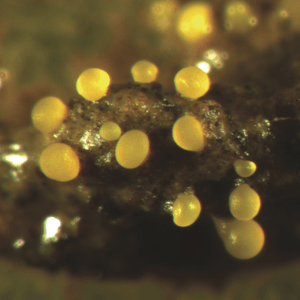Myxobacteria facts for kids
Quick facts for kids Myxobacteria |
|
|---|---|
 |
|
| Myxococcus xanthus | |
| Scientific classification | |
| Kingdom: | |
| Phylum: | |
| Class: |
Deltaproteobacteria
|
| Order: |
Myxococcales
|
The myxobacteria ("slime bacteria") are a group of bacteria that usuallly live in the soil. They feed on insoluble organic substances. They have very large genomes compared to other bacteria. Myxobacteria are included in the delta group of proteobacteria, a large group of Gram-negative forms.
Myxobacteria move by gliding on the surface. They travel in swarms with many cells kept together by intercellular molecular signals. The swarm puts out extracellular enzymes to digest food. This increases feeding efficiency.
Life cycle
When nutrients are scarce, myxobacterial cells aggregate into fruiting bodies. These fruiting bodies are different shapes and colours, depending on the species.
Inside the fruiting bodies, cells develop into rounded myxospores with thick cell walls. These myxospores, like spores in other organisms, survive until nutrients are more plentiful. Then cell growth is restarted with a group (swarm) of myxobacteria, not just isolated cells. Similar life cycles have developed among the amoebae called cellular slime moulds.
Uses
Myxobacteria produce a number of biomedically and industrially useful chemicals, such as antibiotics, and export those chemicals outside of the cell. Some myxobacteria are used as model organisms for the study of development. At a molecular level, initiation of fruiting body development is regulated by Pxr sRNA.
See also
 In Spanish: Mixobacterias para niños
In Spanish: Mixobacterias para niños

